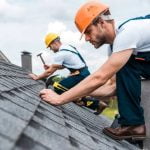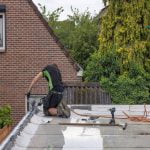
Understandably, homeowners will first consider aesthetics when choosing the style of their new roof. While this is important, architects, for example, would consider efficiency, lifespan, durability, and the best protective barrier against weather. There are numerous types of roof to choose from.
So, when it comes to new build projects, choosing a roof shape can be challenging, especially with so many different roof types featuring their own unique properties.
Below, we break down the most used roof designs, their benefits, durability, and cost per yard. Please note, rubber roofing and EPDM roofing materials are only suitable for roofs that are flat or have a very low pitch. FAQs.
Ranked – Types of Roofs
Tips from roofing experts

ROOM TYPE 1: Flat Roof
- Durability: 40-50 years
- Benefits: Easier to repair. Highly durable. Almost completely weatherproof.
Flat roofs are low-sloped roofs types that appear flat and allow water to run off by channelling it to a drain. With flat roofs, waterproofing materials are essential to guarantee optimal watertightness and prevent leaking. More on flat roofs.
Flat roofs are widely regarded as an efficient way to maximise space in a building. Plus, as the surface area is the same as the house, they are cheaper to install than sloping roofs. They are often used in commercial and institutional facilities and residential extensions.
As they do not drain the same way as pitched roofs, they can be prone to leaking without professional sealing, which might require more regular maintenance. However, they are easier to repair and maintain than other types of roofs. See parapet flat roofs or Commercial flat roofs.
- Shed rubber roof kits from £36.10
When choosing a roof design and material, you don’t need to consider this only for your main property but also for outhouses, sheds, and garages.
Garage roofs in the UK need to withstand low temperatures, prevent water ingress, and encourage good ventilation to protect your items stored from harsh British weather.
As most garage roofs are flat, sheets or tiles are not always suitable to protect from leaks or condensation. Rather, garage EPDM roof membranes are specially designed to withstand the challenges of flat roofs, making it a great material choice. See products.
Non-flat garage roofs tend to use a mono-pitch roof type.
- Garden roof kit (very affordable from £167.58)
Residential-grade Garden rooms are extremely popular and boost your property’s value. Seeing as their construction is highly modern and sleek, they tend to always feature flat roofs, with the go-to material of choice being EPDM rubber for it’s numerous benefits. Check out rooflights to make the space even more modern-looking.
- Extension roof kit £279.76
For any homeowner building a single-story extension to their property looking to keep costs low, and opting for a modern solution should consider the flexible, simple and affordable flat roof solution. Great for extensions of any shape or size, flat roofs featuring rubber materials are cheaper and faster to create. Plus, they’re easy to maintain and repair.
Roof Type 5: Gable Roof
- Durability: 40 years
- Benefits: Excellent drainage for rain and snow and more weather resistant. Better ventilation within the home.
Gable roofs types are popular and common as they are easy to build and shed water well. It’s the most basic type of sloping roof, consisting of two equally sized sloping roof surfaces which meet at the top ridge of a rectangular house. As the triangle shape is the most stable form in engineering, the gable roof is strong, making it a popular choice for British homes. Plus, they allow for larger loft spaces.
A drawback to be aware of with Gable Roof types is that they are more prone to wind damage as the gable roof structure can attract wind, which can damage the shingles. So, if you live in an area prone to high winds or extreme weather, gable roofs are not the best choice.
Similar roofs are T-shaped and L-shaped.

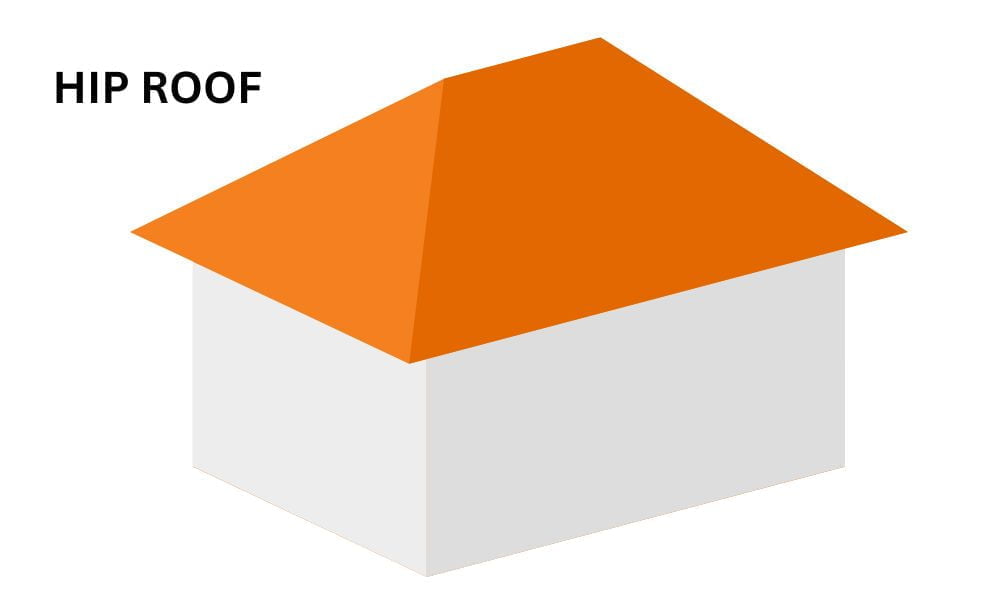
Roof Type 6: Hip Roof
- Durability: 40-50 years
- Benefits: Great for high wind and snowy areas, leaving no standing water.
Another popular roof, the hip roof, which is pyramid-shaped, allows for better performance in areas with strong winds due to extreme vertical elements. However, gable roofs do not allow optimal ventilation or provide as much roof space for loft spaces. Hipped roofs with a high pitch are more popular on properties or institutions as they are simple to build.
The inward slope of all four sides makes this roof type sturdier and more durable, which is a definite advantage in extreme climates. More.
Roof Type 7: Dutch Roof
- Durability: 60 years
- Benefits: Great for high wind and snowy areas, leaving no standing water.
The Dutch roof is unique because it combines the benefits of the gable and hipped roof. The main benefits are that the design facilities access to the underside of the roof and adds extra space and natural light within the property. Best used in residential projects to add a higher flare of design whilst maximising space, Dutch roofs feature high strength and optimal water drainage.
Not as common as alternatives in the UK, the Dutch roof is often referred to as a Gablet roof, which allows for more standing room in a loft space but is more complex and costly to create.

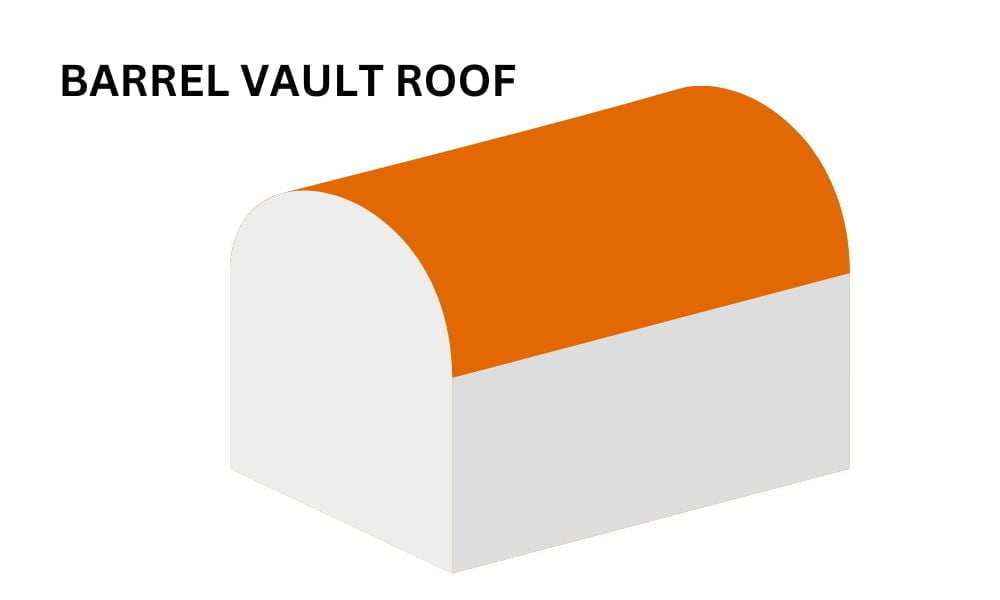
Roof Type 8: Barrel vault roofs
- Durability: 50-100 years
- Benefits: Complete resistance to wind, hail, and fire damage.
The Barrel roof type uses a continuous arch shape, like a semi-circle, to create a curved style of room and is often paired with a metal roof tile solution. In the UK, it’s often seen in the architecture of churches or museums, or in the form of shelters, taking inspiration from Spanish and Mediterranean styles.
However, a high barrel tile roofing system can generally cost two to three times as much as an asphalt roof.
Roof Type 9: Shed Roof
- Durability: 10-50 years, depending on the material.
- Benefits: Good for extensions and attached buildings.
Shed roofs are very similar to flat roofs, but they have more pitch and tend to be used more as additions to properties with other roof styles. The single-pitched roof is a single gable that slopes to one side and is not connected to other parts of the property.
Drainage is effective and simple, with no connection points to other slopes, making it easier to maintain. It’s a low-cost, long-lasting material, making it a popular choice. More.


Roof Type 10: Butterfly Roof
- Durability: Up to 50 years.
- Benefits: Good aerodynamic properties. Resistant to weather damage from high winds.
Also referred to as the V-roof, the Butterfly roof is modern and aesthetically pleasing, where the roof slopes inwards, making it an inverted gable roof. However, it’s typically associated with the mid-20th century and modern US architecture. The Butterfly roof type provides adequate ventilation but prevents challenges for draining water as the rain is collected and then channelled to a drain.
Roof Type 11: Gambrel Roof
- Durability: With the right maintenance, it can last over a century. Depending also on material.
- Benefits: Suitable for most climates. Increased interior space.
Typically used in contemporary barns, a gambrel roof is like a gavel roof, but instead of being triangular, it pitches at two different angles that are steeper at the bottom. It provides more space in the loft and is better suited for living space; however, the weight can sometimes push the steep outwards. The design is most commonly seen in traditional American aesthetics.


Roof Type 12: Dormer Roof
- Durability: Up to 50 years.
- Benefits: Good aerodynamic properties. Resistant to weather damage from high winds.
Typically, a dormer roof, is an addition to an existing roof, where a window and a roof, whether gable, hipped or flat protrudes 90 degrees from the existing slope. The addition of a dormer roof creates usable space extending from the roof to provide more natural light and headroom.
Roof Type 13: M Shaped Roof
- Durability: Up to 50 years.
- Benefits: Good for natural light when windows are installed. Extra storage space.
Typically seen with semi-detached houses or extensions, m-shaped roofs are double gables roofs with two sloped sides that meet in the middle, creating an M shape. They allow for better natural light to enter and have a central gutter to prevent snow and rain from building up. It’s not a common roof type for single homes, but the shape can be incorporated into modern designs.
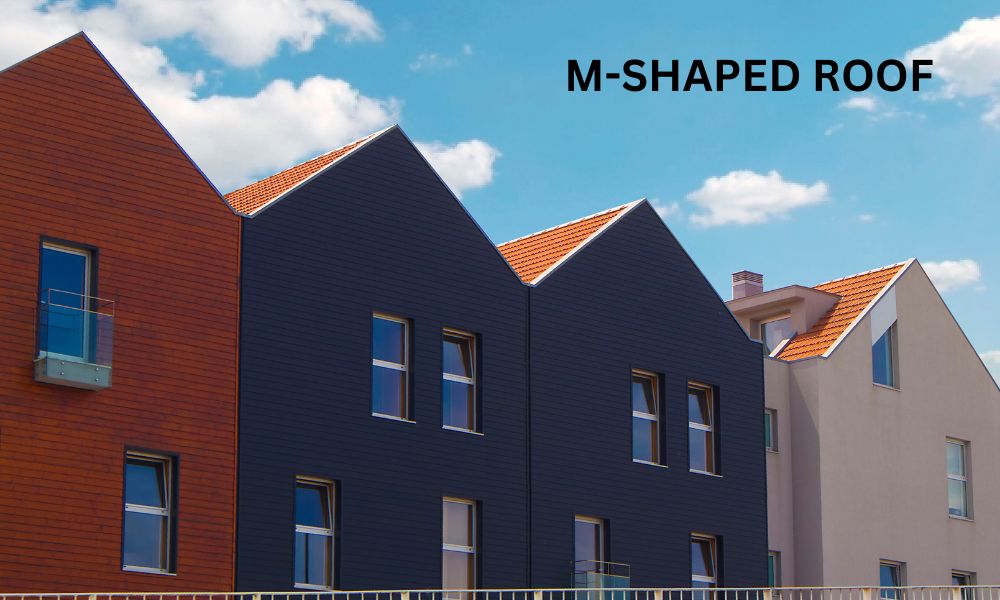

Porch Roofs
- Durability: 40-50 years.
- Benefits: Increased home value, additional space and improved aesthetics.
Porch roofs can feature several shapes, from flat to pitch, with the type you choose is based on the fitting of the house’s overall design or made on a price decision. The most common porch roof tends to be a gable roof. However, more homes nationwide are opting for flat roofs as an alternative.


